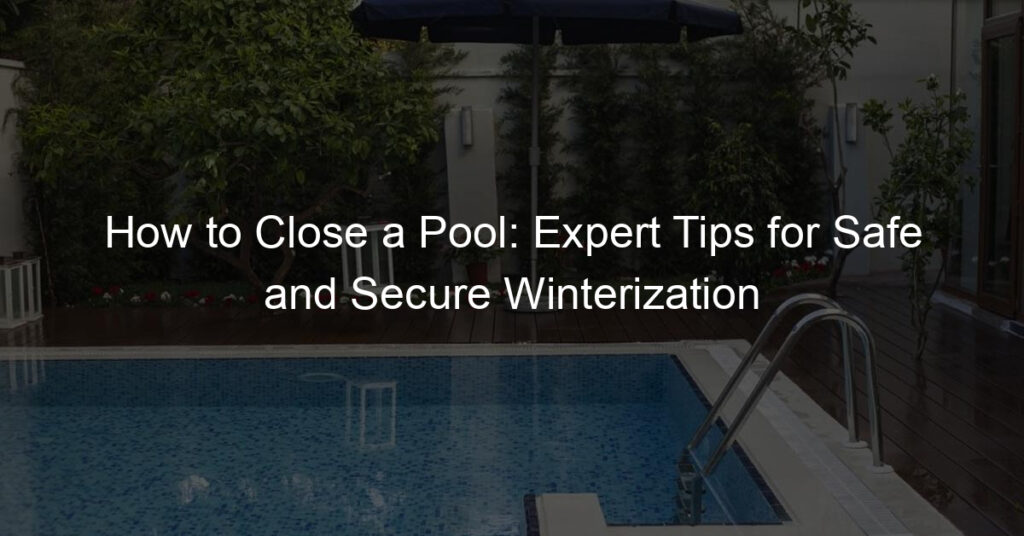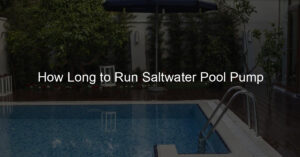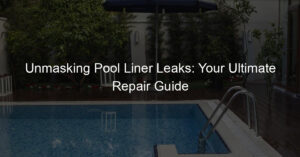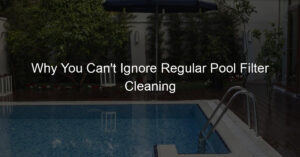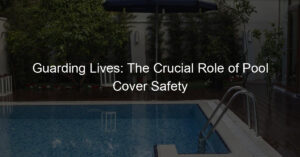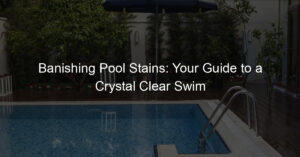How to Close a Pool: Expert Tips for Safe and Secure Winterization
As a pool owner, I know that closing a pool for the winter season is an essential task to keep the pool in good condition and prevent any damage caused by freezing temperatures. It’s important to understand what steps to take and which specialized equipment and chemicals to use to ensure the proper winterization of the pool. Checking the water chemistry, cleaning the pool, and protecting it with a quality cover are some crucial aspects of the closing process.
Preparing an inground pool for winter differs slightly from an above-ground pool, but the overall goal is the same: preventing potential damage to the pool structure, equipment, and plumbing. Water chemistry is important to maintain even during the closure process, as it helps protect the pool from algae growth and avoids damage to pool surfaces. Closing the pool when the water temperature is consistently below 65°F (18°C) can also help reduce algae growth, keeping the water clearer for longer.
Key Takeaways
- Closing a pool properly is crucial to prevent damage during the winter months
- Maintaining water chemistry and utilizing specialized equipment ensures a successful winterization process
- Differences exist between inground and above-ground pool closing procedures.
Understanding the Importance of Pool Closing
As a pool owner, I know that proper pool closing is an essential step to protect my investment and ensure my pool is ready for use when the swim season returns. It cannot be stressed enough how vital this process is for maintaining my pool during the off-season.
In my experience, a primary reason for closing my pool is to prevent potential damage caused by freezing temperatures and winter conditions. By following the right steps, I can avoid costly repairs and keep my pool in top shape for the next swim season. Plus, it saves me time and energy when reopening my pool in the spring.
One important aspect of pool care during the off-season is managing the chemistry of the pool. Ensuring that the water is appropriately balanced before closing my pool helps prevent the growth of algae and bacteria. This makes reopening much smoother, reducing any algae blooms or foul odors that often accompany an improperly closed pool.
I also find that closing my pool prevents debris from accumulating in the water, which would lead to more time-consuming cleanup in the spring. By keeping my pool free of leaves, dirt, and other debris, I’m ultimately reducing the potential for staining and damage to the pool’s surfaces, prolonging the pool’s lifespan.
Finally, closing a pool properly helps me avoid possible issues with the pool equipment. When I properly winterize my pool’s plumbing systems, pumps, and filters, I can be confident knowing they won’t freeze or suffer damage over the winter months.
In conclusion, properly closing my pool goes a long way in ensuring its health and longevity. By being diligent with off-season pool care, I’m not only saving time and energy but also protecting my investment and extending the life of my pool. Following a comprehensive pool closing process allows me to sit back and enjoy the off-season, knowing that my pool will be ready and in great shape when swim season returns.
Checking the Water Chemistry
Assessing the Ph Levels
Before closing my pool, I always make sure to assess the pH levels in the water. Maintaining the right pH level of the pool water is essential for preventing corrosion or scaling on pool surfaces and equipment. I test the water using a test kit and adjust the levels if necessary. If the pool’s pH level is below 7.2, I use a pH increaser to raise it. On the other hand, if the pH level is above 7.8, I use a pH decreaser to lower it.
Managing Calcium Hardness
Another essential aspect of water chemistry I check before closing my pool is calcium hardness. It is important to maintain proper calcium hardness levels in the pool water, between 200 and 400 parts per million (ppm), to prevent issues like scaling and plaster deterioration. If the calcium hardness levels are low, I add a calcium increaser to the water, while high levels can be managed by diluting the pool water.
Inspecting Chlorine Levels
Chlorine is crucial for keeping the pool water sanitary and free of algae. To ensure my pool is ready for winter, I inspect the chlorine levels by measuring the free available chlorine (FAC) and cyanuric acid levels. The ideal FAC level is between 1 and 3 ppm, while cyanuric acid levels should be kept between 30 and 50 ppm. I use a granular oxidizer or pool shock to ensure the chlorine levels are adequate before closing the pool for the season.
Examining Alkalinity
Finally, when closing my pool, I examine the total alkalinity levels to maintain the proper water balance. The total alkalinity affects the pH level, so it is vital to keep it within the recommended range of 80 to 120 ppm.
To increase the alkalinity of the pool water, I use an alkalinity increaser. Conversely, if alkalinity levels are too high, I add an alkalinity decrease or muriatic acid. This helps to prevent pH bounce, which could lead to scaling, etching, and problems with the pool surfaces and equipment.
By carefully checking and adjusting the pH, calcium hardness, chlorine, and alkalinity levels in my pool, I ensure that my pool water is balanced and ready for winter.
Preparing the Pool
Cleaning the Pool
To prepare my pool for closing, the first thing I do is give it a thorough cleaning. I make sure to skim the water surface to remove any debris like leaves or twigs. After skimming, I vacuum the pool using my trusty pool vacuum to get rid of any dirt or algae settled on the bottom. Additionally, using a pool brush, I scrub the walls and floor to dislodge any stubborn dirt or algae that the vacuum may have missed.
Controlling Algae Growth
Algae can be a real problem when it comes to closing a pool, so I take certain measures to prevent its growth. One week before closing my pool, I add a phosphate remover to eliminate algae’s primary food source and help prevent potential algae blooms. I also make sure that the water temperature is consistently below 65 degrees Fahrenheit before closing the pool, as this helps limit the growth of algae.
Draining the Pool to the Correct Level
When preparing my pool for the winter season, I need to ensure the water level is properly maintained. Draining the pool to the correct level is crucial to avoid potential damage due to freezing. To achieve this, I lower the water level to about 4-6 inches below the skimmer opening or tile line. This helps prevent the water from freezing and causing damage to the pool’s structure or equipment.
Detaching the Ladder
One last important step I take when preparing my pool is to remove any accessories, such as ladders, diving boards, or slides. This ensures these components are safe from damage due to freezing temperatures or any other potential winter-related issues. After removing these items, I make sure to store them in a secure, dry place until it’s time to reopen the pool for the next season.
Utilising Specialised Equipment
Understanding the Pool Filter
One essential piece of equipment I use when closing a pool is the pool filter. The filter plays a significant role in maintaining the cleanliness of the water during the pool season, and it’s just as important to clean and winterize it before closing the pool.
To do this, I make sure to backwash the filter thoroughly, which helps remove any dirt and debris that may have accumulated inside. Once backwashed, I turn off the pool pump and drain the filter. If I’m using a cartridge filter, I remove the cartridge, clean it, and store it indoors for the winter months.
Operating the Pool Pump
Another key component in the pool closing process is the pool pump, which circulates the water and prevents it from becoming stagnant. Before closing the pool, I ensure that the water is properly balanced and sanitized. I then use an air compressor to blow out the water from the pool pump, skimmer, and return lines to help prevent any freezing damage during the colder months. Once the lines are cleared, I close them off using winterizing plugs to seal them and keep them dry.
Incorporating a Cover Pump
Finally, when covering the pool, I find it essential to use a pool cover pump to prevent water and debris from accumulating on top of the pool cover. A cover pump is designed to automatically remove excess water from the surface of the pool cover, minimizing the risk of algae growth and protecting the cover itself from damage due to excess weight. By utilizing a cover pump, I ensure that my pool remains protected throughout the winter, making it much easier to open in the spring.
Applying Necessary Chemicals
Executing a Shock Treatment
To effectively close my pool, I start by executing a shock treatment. This involves raising the chlorine levels to kill bacteria and sanitize the water. I use a chlorine-free pool shock product, which I add to the water two days before closing my pool. This allows sufficient time for the chemicals to work and ensures that my pool will be free of contaminants during the winter months.
Applying an Algaecide
In order to prevent algae growth over the winter, it’s essential for me to apply an algaecide to the water. I do this just before covering my pool, as it helps to keep the water clear and algae-free. By using an algaecide, I’m taking a proactive step against potential algae blooms, ensuring that my pool remains in good condition when it’s time to reopen in the spring.
Using a Sanitizer
It’s important to maintain the proper chlorine level in my pool during the closing process. I use solid calcium hypochlorite tablets or granules to sanitize the water and keep it clean throughout the winter. By maintaining the correct sanitizer levels, I can be confident that my pool will remain devoid of bacteria and other harmful contaminants.
Adding Antifreeze
One key step in closing my pool is adding antifreeze to the water. This ensures that my pool’s plumbing system remains protected from freezing temperatures during the winter months. To do this, I follow the manufacturer’s instructions for the proper amount of antifreeze to use, based on the size and type of my pool.
Utilising Pool Enzymes
Finally, I incorporate pool enzymes into my closing routine. These enzymes help break down and remove organic contaminants, such as oils and lotions, that can accumulate in the water over time. Adding pool enzymes to my end-of-season maintenance process ensures that the water remains clear and well-balanced when it’s time to reopen the pool in the spring.
Proceeding with the Winterisation Process
Covering the Pool
When it’s time to winterize my pool, I start by choosing the right winter cover. A high-quality pool cover is essential for protecting my pool from debris and harsh weather conditions. I prefer using a safety cover, as it provides extra security and prevents accidents.
After ensuring the water level is adjusted correctly, I place air pillows in the pool. These air pillows help prevent the formation of ice and alleviate pressure on the pool walls. Next, I spread the winter cover evenly over the pool, ensuring it fits securely around the edges.
Lastly, I use a cover pump to remove excess water, which helps maintain the cover’s effectiveness throughout the winter months.
Protecting Pool Accessories
Before closing my pool, I pay special attention to my pool accessories. To keep them free from damage, I remove them from the pool area and store them in a dry, safe location. This includes items like ladders, handrails, and pool toys.
In addition to storing these accessories, I also take care of my pool equipment by winterizing it. I use a pool closing kit and winterizing chemicals to prepare the water for the colder months. This includes balancing the pH levels and adding shock and algaecide to the water.
To protect the skimmer and return lines from freezing, I use plugs and antifreeze. This helps prevent potential damage during the winter months, making reopening the pool in spring much easier.
By carefully following these steps and using high-quality products such as a winter pool cover, air pillows, leaf net, and closing chemicals, I can confidently winterize my pool, knowing it will be in optimal condition come springtime.
Preventing Potential Damage
As I close my pool, I want to make sure that I’ve considered all of the potential issues that could arise during the winter months. There are a few main concerns when it comes to winter pool maintenance – corrosion, bacteria, stains, and freeze damage. By taking proper precautions, I can help protect my pool and reduce the amount of work needed when I reopen it.
In order to prevent corrosion, I’m conscious of the chemicals I use when closing my pool. It’s essential for me to maintain a proper balance throughout the winter months, as this can help prevent damage to the pool’s surfaces and metal components. I typically use chemical test strips to ensure the right balance of chemicals before I close my pool.
To fend off bacteria and reduce the risk of stains, I start by cleaning the pool thoroughly before shutting it down for the season. By removing debris and pool scum, I significantly decrease the chance of algae and bacterial growth. It’s also important for me to use a quality pool cover to keep out additional debris and prevent sunlight from reaching the water, which can contribute to algae growth.
To protect my pool from freeze damage, I take steps such as draining and cleaning my pool lines, as well as sealing my skimmer. I make sure to remove all the water from my lines before storing them to avoid any freezing and potential damage. These actions help me preserve my pool plumbing and equipment, which makes reopening my pool in the spring a smoother process.
By being proactive and attentive when closing my pool for the winter, I can confidently protect it from various types of potential damage. The steps I take now will ensure that my pool is ready for a hassle-free opening when warmer weather returns.
Comparing Pool Types
Closing an Inground Pool
When it comes to closing an inground pool, I have learned that it is crucial to first clean the pool thoroughly by removing any debris and pool scum. This ensures that the pool remains bacteria-free during its closed period. Next, I make sure to balance the water’s chemical levels and give the pool shock treatment with a fresh chlorine pack or tablet.
Powering down and winterizing any water features like fountains, waterfalls, or sprinklers is another vital step. Finally, I drain the water from the pool’s equipment and pipes to prevent potential freeze damage during colder months. By properly closing an inground pool, I avoid expensive damages and save on energy costs.
Closing an Above Ground Pool
When it comes to above ground pools, there are also specific steps to follow for proper pool closure. Just like with inground pools, I start by cleaning the pool and ensuring it is free of debris. Balancing the chemical levels in the water is essential to prevent water discoloration and algae growth during the off-season.
Once the water chemistry is balanced, I focus on draining the water below the skimmer level. This helps to protect the liner and pool equipment from freezing temperatures. It is also crucial for me to disconnect and store the pool equipment, such as the pump, filter, and ladder.
Following these procedures ensures that my above-ground pool is properly closed and protected during the winter months.
Conclusion
As a pool owner, I understand the importance of properly closing my pool at the end of the season. By following a well-planned checklist and adhering to best practices in pool care, I can ensure that my pool remains in good condition and is ready for use when the next pool season arrives.
Throughout the process of closing my pool, I make sure to thoroughly clean all surfaces, remove debris, and balance the water chemistry. This not only makes it easier to open the pool in the future but also prevents the growth of algae and bacteria.
A key part of my process has always been to maintain the water temperature below 65 degrees Fahrenheit when closing the pool to avoid algae growth.
When it comes to pool care, safety is also essential. I take the necessary precautions to ensure all equipment is properly stored, and I securely install pool covers to prevent accidents. By doing so, I can have peace of mind knowing that my pool area is safe during the off-season.
In summary, closing a pool requires careful planning and execution. By staying organized, following a checklist, and paying attention to pool care best practices, I can ensure my pool remains in top condition. This allows me to enjoy the benefits of a well-maintained pool season after season.
Frequently Asked Questions
What is the proper procedure to close an inground pool?
I recommend starting the process once the water temperature is consistently below 65 degrees Fahrenheit. The main steps include balancing the water, lowering the water level, preparing the filtration system, and covering the pool. I advise checking for specific requirements depending on your pool equipment and configuration.
At what chlorine level should I close my pool?
It’s best to close your pool when the chlorine levels are between 1-3 ppm, which is the ideal range for maintaining proper water balance. Ensure the water chemistry is balanced, including pH, alkalinity, and calcium hardness levels.
What month is best for closing a pool?
It depends on the climate in your area. In general, I suggest closing your pool when the water temperature is consistently below 65 degrees Fahrenheit to prevent algae growth. This typically occurs in late September or early October, depending on your location.
How much shock is needed to close a pool?
I recommend following the manufacturer’s instructions on the shock product you use. Usually, you’ll need to use more shock than you would for regular maintenance, as you want to ensure the water is sanitary and algae-free throughout the winter.
What are the steps to close a saltwater pool for winter?
Closing a saltwater pool is similar to closing a chlorinated pool. However, there are a few additional steps, such as turning off the salt system and storing the salt cell indoors. Balance the water, lower the water level, protect the filtration system components, and cover the pool. Don’t forget to consult your salt system’s guidelines for winterizing the equipment.
Which type of winter pool cover should I use?
There are several types of pool covers to choose from, depending on your budget and needs. Some common options include solid covers with mesh panels for drainage, mesh covers that allow water to pass through while blocking debris, and safety covers that provide added protection against accidental falls. Consider factors such as durability, ease of installation, and compatibility with your pool shape when selecting a cover.

